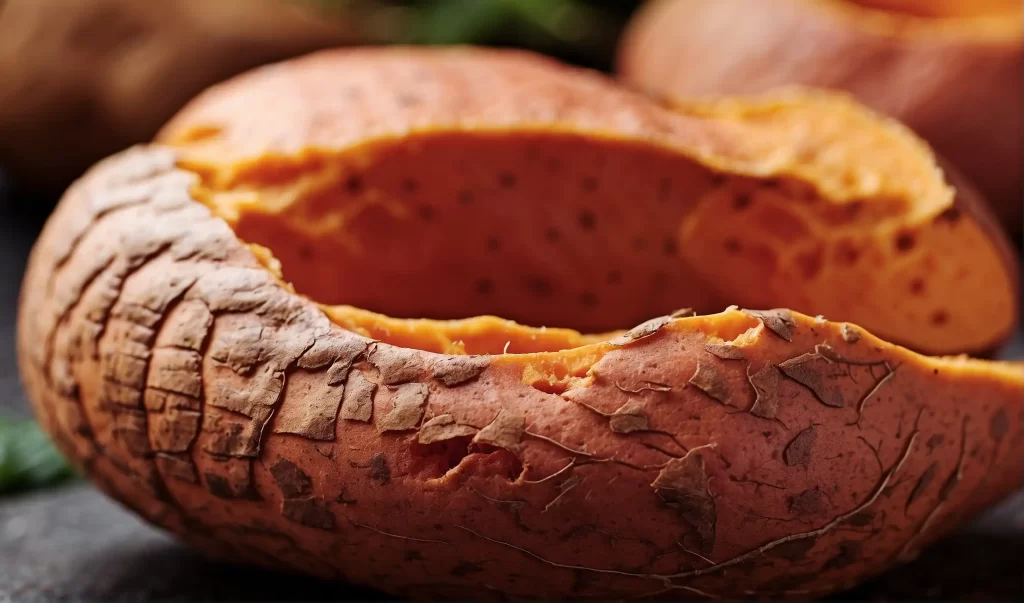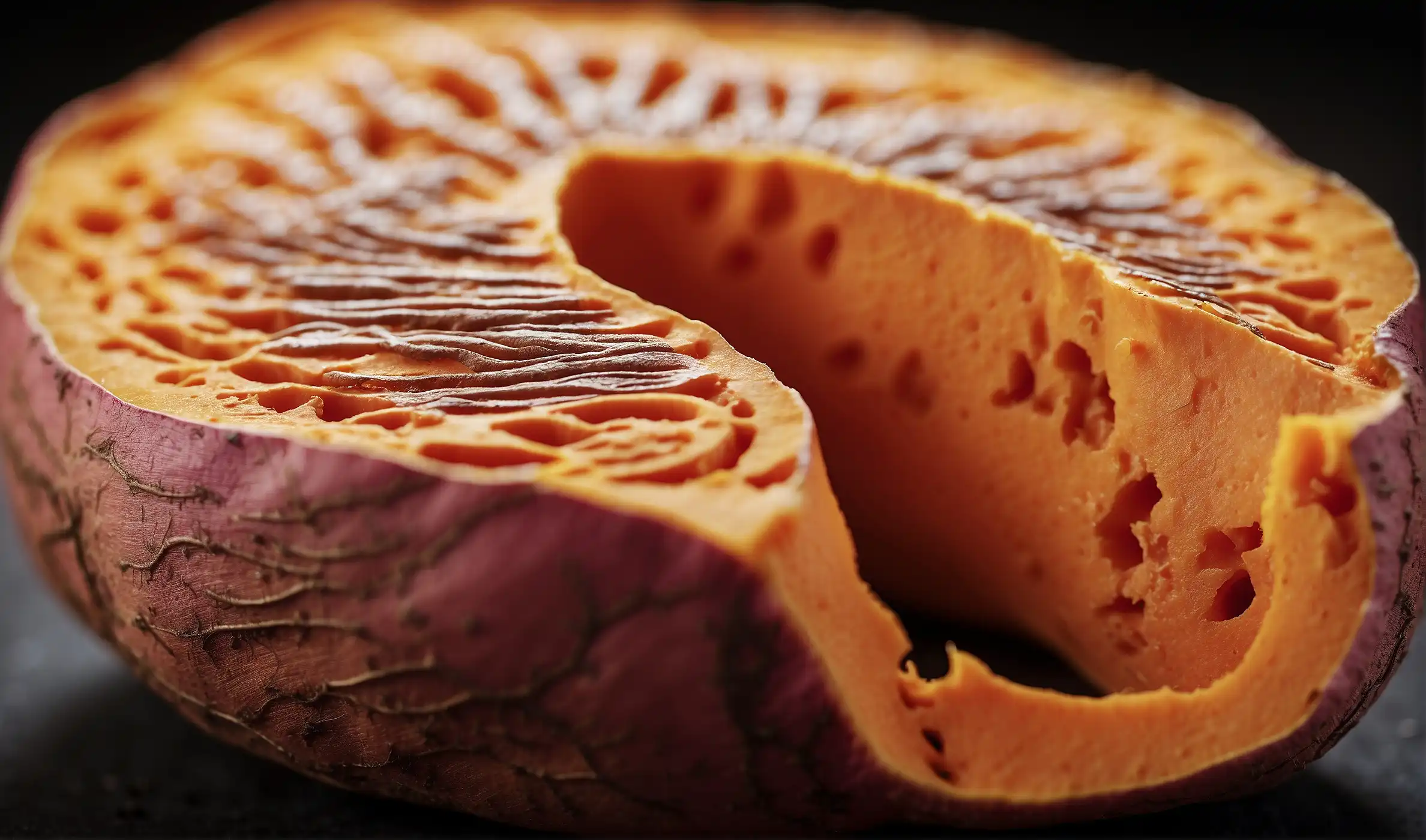Sweet potatoes have veins to transport nutrients and water throughout the plant. These veins are part of the tuber’s vascular system.
Sweet potatoes, a root vegetable high in vitamins, minerals, and fiber, feature a network of veins that are crucial for their growth. These veins are actually specialized structures that carry water, minerals, and sugars produced through photosynthesis from the plant’s leaves to the rest of the developing tuber.
As a starchy, sweet-tasting root, sweet potatoes not only offer a wealth of health benefits but also serve as a versatile ingredient in various culinary creations. Gardeners and farmers pay close attention to the health of these veins, as they are indicative of the sweet potato’s overall health and development. Understanding the role of these veins can provide insights into the best practices for cultivating and harvesting this nutritious crop.
Sweet Potato Vascular Tissue Functions
The sweet potato’s vascular system plays a crucial role in the plant’s overall health and functionality. This complex network is responsible for the efficient transportation of nutrients and water from the roots to the rest of the plant. These nutrients fuel the growth of the sweet potato, allowing it to develop its characteristic flavor and texture.
Apart from nutrient distribution, the vascular tissue provides essential structural support. The veins you observe in a sweet potato are part of this support system, giving it stability and shape. Their presence is particularly important as the tuber grows in size and mass.
The Science Behind Veins In Sweet Potatoes
The intriguing veins of sweet potatoes are integral to their plant anatomy and vein system. These critical structures, comprising the phloem and xylem, serve as the lifelines of sweet potatoes. The phloem distributes essential nutrients from photosynthesis, while the xylem carries water and minerals from the soil to all parts of the plant.
Their function in sweet potatoes mirrors the role they play in other root vegetables. Yet, sweet potatoes are unique due to their distinct flesh pattern, which often showcases pronounced vein markings. Unlike some root vegetables where veins might be more subtle or hidden, sweet potato veins are quite detectable and visually accentuate the tuber’s internal structure.
| Vegetable | Phloem Function | Xylem Function |
|---|---|---|
| Sweet Potato | Nutrient distribution | Water and mineral transport |
| Carrot | Nutrient distribution | Water and mineral transport |
| Beetroot | Nutrient distribution | Water and mineral transport |
Such a comparison highlights that while the functional roles are consistent across root vegetables, sweet potatoes’ veins are notable for their distinct patterning, affecting not just their aesthetics but potentially their textural characteristics, too.

Anatomy and Varieties Of Sweet Potatoes
Sweet potatoes exhibit a fascinating range of anatomical variations, most notably in their vein structures. Depending on the variety, these vascular patterns can differ significantly, contributing to the tuber’s unique appearance and qualities. Sweet potato veins serve not only for nutrient transport but also influence the texture and sweetness of the vegetable. More pronounced vein structures often lead to a firmer texture, which can affect cooking outcomes.
The diversity among sweet potatoes includes several popular types like the Beauregard, known for smooth skin and vibrant orange flesh, and the Purple Stokes, characterized by a deeper hue and denser nutrient profile. Japanese sweet potatoes, with their distinct purple skin and white flesh, have a different vein architecture that contributes to their uniquely sweet flavor. These varieties showcase how vein patterns and densities interact with the sweet potato’s characteristics.
Recognizing the correlation between vein patterns and the resultant taste and texture can guide culinary choices. Chefs and consumers alike may choose a specific sweet potato variety based on the desired outcome in a recipe, be it sweetness or a particular mouthfeel. Thus, understanding the anatomy and vein differences in sweet potatoes is key to fully appreciating and utilizing this versatile root vegetable in the kitchen.
Varietal Impact On Sweet Potato Veins
Sweet potatoes are highly regarded for their nutritional benefits and distinct appearance. One intriguing feature of these tubers is their vein structure, which can significantly vary across different cultivars. The complexity and pattern of these veins are not only influenced by genetic factors but also by the specific environmental conditions under which the sweet potatoes are grown. Soil type, climate, irrigation practices, and nutrient availability play crucial roles in determining the prominence and distribution of veins in sweet potatoes.
Different varieties have been breed to display certain characteristics, and these genetic determinants play a key role in how veins develop. Certain genes may dictate the vein structure leading to more pronounced and visible veins, while others might result in a subtler vein network. Understanding the interaction between these genetic predispositions and environmental impacts is essential for farmers and breeders aiming to cultivate sweet potatoes with ideal aesthetic and textural qualities.
Sweet Potato’s Nutritional Pathways
The intricate network of veins in sweet potatoes plays a crucial role in the distribution of nutrients throughout the tuber. These veins, essentially the plant’s vascular system, transport water and vital nutrients such as minerals and vitamins from the soil to every part of the sweet potato.
Important nutrients like potassium, vitamin A, vitamin C, and beta-carotene are conveyed through these channels, contributing to the sweet potato’s rich nutritional profile. The presence of veins ensures a consistent supply of these elements, which are essential for maintaining the tuber’s health and development.
This well-developed vascular system not only supports the sweet potato’s growth but also enhances its quality. As a result, sweet potatoes with a robust network of veins are likely to offer more nutritional benefits, making them a valuable addition to a health-conscious diet.
Why Vein Health Matters In Sweet Potatoes
Sweet potatoes with prominent and healthy veins are generally considered superior in quality. The vein structure in sweet potatoes can be a visual indicator of the tuber’s overall health and vitality. Sweet potatoes displaying strong, clear veins often suggest a nutrient-rich, well-developed root, free from disease and pests.
The vein robustness in sweet potatoes also correlates with a longer shelf life and improved culinary performance. These attributes are particularly appealing both to consumers and those in the culinary industry. A healthy vein system in the tuber can better store starches and sugars, leading to an improved taste profile and texture upon cooking.
Furthermore, the link between vein structure and disease resistance is a critical consideration in sweet potato cultivation. Varieties with stronger vein systems are generally more capable of withstanding diseases, thus ensuring better crop yields and reduction in post-harvest losses. This resistance to pathogens directly impacts the viability of sweet potato crops from a commercial perspective.
Also learn: When Do You Plant Sweet Potatoes in Texas
Harvesting And Storage Effects On Veins
Sweet potatoes exhibit veins that are crucial to their nutritional quality and aesthetic appeal. Maintaining vein integrity during harvesting and storage is essential. To ensure the preservation of these veins, gentle handling is imperative during harvest to prevent bruising and damage. Once harvested, the sweet potatoes should be cured; this involves keeping them at a high humidity level and a temperature of approximately 85°F (29°C) to heal any damage to the skin and reduce the chances of decay.
Consistent temperature and humidity levels are vital during the storage phase. The ideal storage conditions are a humidity of 85-90% and a temperature range of 55-60°F (13-16°C). Such an environment helps to minimize dehydration and weight loss, preserving the structural integrity of the veins. Sudden temperature changes can lead to the development of stress lines in the veins, compromising their structure.
| Harvesting Technique | Curing Conditions | Storage Conditions |
|---|---|---|
| Gentle handling, immediate cleaning of soil | 85°F (29°C), high humidity for 7-14 days | 55-60°F (13-16°C), 85-90% humidity |
Improving Sweet Potato Shelf-life And Quality
Understanding the nutritional pathways within sweet potatoes means recognizing that the presence of veins is indicative of vitamin and mineral distribution throughout the tuber. Ensuring these pathways remain unblocked is essential for maintaining the nutrient-rich profile of the sweet potatoes. Storage conditions play a pivotal role in this, requiring temperatures that discourage spoilage yet preserve the complex network of veins.
Innovative storage techniques have a direct impact on the vein structures of sweet potatoes. By controlling environmental factors such as humidity and light, we can extend shelf-life and keep those veins vibrant and nutrient-dense. Techniques might include using climate-controlled storage units or anti-ethylene technologies to slow down the natural ripening process.
For consumers, selecting sweet potatoes with bright, pronounced veins can be a marker of quality. Vigorous veins often signal a sweet potato that has been stored correctly, suggesting a better taste and higher nutritional value. Inspecting the firmness of the potato and evenness of the skin alongside the vein health can guide buyers towards the finest produce available.
FAQs For Why Do Sweet Potatoes Have Veins
What Causes Sweet Potatoes To Have Veins?
Sweet potatoes contain veins due to their vascular system, which transports nutrients and water. They are essential for the tuber’s growth and nutrient distribution, much like veins in a leaf.
Are Sweet Potato Veins Safe To Eat?
Absolutely, sweet potato veins are safe to eat. They are natural parts of the potato’s anatomy, carrying nutrients and water throughout the tuber. Their texture might be slightly different, but they pose no harm.
Do Sweet Potato Veins Affect Taste?
No, sweet potato veins typically do not affect taste. They may alter texture slightly but the overall flavor profile of the sweet potato remains unaffected by the presence of these veins.
Can You Remove Veins From Sweet Potatoes?
While you can remove veins from sweet potatoes, it is unnecessary. They are edible and do not detract from the sweet potato’s quality or flavor, so most people cook them with the veins intact.
Conclusion
Unlocking the mystery of sweet potato veins has been an intriguing journey. These natural formations ensure nutrient distribution, supporting healthy growth. Embracing sweet potatoes in our diet not only offers nutritional benefits but also a glimpse into the wonders of plant biology.
Delve deeper, and you’ll find nature’s ingenuity at every meal. Keep exploring, and happy eating!
Stay engaged with Farm Pioneer for more insights into the wonders of plant biology and innovative farming techniques.
